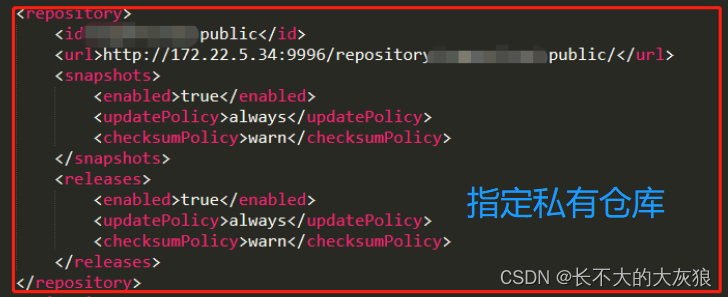热门标签
热门文章
- 1Flask中的网页数据url设置、数据传递和数据显示相关设置_flask第一个页面数据传入其他页面
- 2SpringBoot+OAuth2+JWT实现单点登录SSO完整教程,竟如此简单优雅!
- 3全新SQL Server教程_sql教程新3721
- 4easyExcel导入导出(列锁定单元格、表头合并、导出类型限制、锁定单元格增加底色、设置密码、隐藏列等)_easy excel sheetwritehandler 隐藏列
- 5Spring MVC 原理+底层实现_springmvc工作原理
- 6R语言04-R语言中的列表_r 创建list
- 7OpenCV实战项目——多种颜色识别
- 8Spring Cloud Alibaba 整合Seata 之概念介绍及Seata-server搭建_seataserver
- 9开源大模型发展汇总_大模型开源调研
- 10Vue3动态路由 - 动态添加菜单权限路由以及next_vue3 next
当前位置: article > 正文
Maven配置私有库_pom repository
作者:Monodyee | 2024-02-15 22:59:08
赞
踩
pom repository
一、仓库
仓库类型:
本地仓库、远程中央仓库、公司自己搭建的私有仓库
寻找jar的基本优先级顺序:
本地仓库 > settings.xml的profile的仓库 > pom.xml的profile的仓库 >pom.xml的仓库 > 中央仓库
设置仓库的方式有两种,一种是在项目最顶级POM.xml中设置,另一种是在settings.xml中设置。
在POM.xml中设置:
<repositories> <repository> <id>nexus</id> <name>Team Nexus Repository</name> <url>http://192.168.100.100:8181/nexus/content/groups/public</url> </repository> <repository> <id>thirdparty</id> <name>Nexus thirdparty</name> <url>http://192.168.100.100:8181/nexus/content/repositories/thirdparty/</url> </repository> </repositories> <pluginRepositories> <pluginRepository> <id>nexus</id> <name>Team Nexus Repository</name> <url>http://192.168.100.100:8181/nexus/content/groups/public</url> </pluginRepository> </pluginRepositories>
- 1
- 2
- 3
- 4
- 5
- 6
- 7
- 8
- 9
- 10
- 11
- 12
- 13
- 14
- 15
- 16
- 17
- 18
- 19
settings.xml中设定:
<?xml version="1.0" encoding="UTF-8"?> <settings xmlns="http://maven.apache.org/SETTINGS/1.0.0" xmlns:xsi="http://www.w3.org/2001/XMLSchema-instance" xsi:schemaLocation="http://maven.apache.org/SETTINGS/1.0.0 http://maven.apache.org/xsd/settings-1.0.0.xsd"> <localRepository>/Users/本地仓库地址/Documents/repo</localRepository> <pluginGroups></pluginGroups> <proxies></proxies> <servers> <!-- 发布到仓库中的配置,id要和distributionrepository保持一致 服务器要打包上传到私服时,设置私服的鉴权信息,否和报错 Return code is: 401, ReasonPhrase: Unauthorized --> <server> <id>release</id> <username>deployment</username> <password>123456</password> </server> <server> <id>snapshot</id> <username>deployment</username> <password>123456</password> </server> </servers> <mirrors> <!-- 设置多个mirrors镜像,镜像只会执行第一个位置mirror。--> <!-- 配置的多个mirror可以都放着不影响,选取一个镜像下载比较快的放在第一个就行。比如你设置使用自己公司的私有仓库--> <!--只有当前一个mirror无法连接的时候,才会去找后一个,类似于备份和容灾。所以当第一个mirror中不存在a.jar的时候,并不会去第二个mirror中查找,甚至于,maven根本不会去其他的mirror地址查询--> <mirror> <!-- 当有id为B,A,C的顺序的mirror在mirrors节点中,maven会根据字母排序来指定第一个,所以不管怎么排列,一定会找到A这个mirror来进行查找,当A无法连接,出现意外的情况下,才会去B查询--> <id>aliyun</id> <name>阿里云仓库地址</name> <url>http://maven.aliyun.com/nexus/content/groups/public</url> <!--覆盖了Maven自带的central--> <mirrorOf>central</mirrorOf> </mirror> </mirrors> <profiles> <!-- 全局JDK1.8配置 --> <profile> <id>jdk1.8</id> <activation> <activeByDefault>true</activeByDefault> <jdk>1.8</jdk> </activation> <properties> <project.build.sourceEncoding>UTF-8</project.build.sourceEncoding> <maven.compiler.source>1.8</maven.compiler.source> <maven.compiler.target>1.8</maven.compiler.target> <maven.compiler.compilerVersion>1.8</maven.compiler.compilerVersion> </properties> </profile> <!-- 阿里云配置: 提高国内的jar包下载速度 --> <profile> <id>aliyun-Repository</id> <repositories> <repository> <id>aliyun</id> <url>http://maven.aliyun.com/nexus/content/groups/public/</url> <releases> <enabled>true</enabled> </releases> <snapshots> <enabled>true</enabled> </snapshots> </repository> </repositories> </profile> <profile> <id>suwell-Repository</id> <repositories> <repository> <id>first</id> <name>Repository first</name> <url>http://192.168.100.100:8181/nexus/content/groups/public</url> <releases> <enabled>true</enabled> </releases> <snapshots> <enabled>true</enabled> </snapshots> </repository> </repositories> </profile> <profile> <id>gomain-Repository</id> <repositories> <repository> <id>second</id> <name>Repository second</name> <url>http://192.168.100.100:8081/nexus/content/groups/public</url> <releases> <enabled>true</enabled> </releases> <snapshots> <enabled>true</enabled> </snapshots> </repository> </repositories> </profile> </profiles> 激活仓库配置,拉取依赖会在这些仓库中逐个去找 <activeProfiles> <activeProfile>jdk1.8</activeProfile> <activeProfile>first-Repository</activeProfile> <activeProfile>aliyun-Repository</activeProfile> <activeProfile>second-Repository</activeProfile> </activeProfiles> </settings>
- 1
- 2
- 3
- 4
- 5
- 6
- 7
- 8
- 9
- 10
- 11
- 12
- 13
- 14
- 15
- 16
- 17
- 18
- 19
- 20
- 21
- 22
- 23
- 24
- 25
- 26
- 27
- 28
- 29
- 30
- 31
- 32
- 33
- 34
- 35
- 36
- 37
- 38
- 39
- 40
- 41
- 42
- 43
- 44
- 45
- 46
- 47
- 48
- 49
- 50
- 51
- 52
- 53
- 54
- 55
- 56
- 57
- 58
- 59
- 60
- 61
- 62
- 63
- 64
- 65
- 66
- 67
- 68
- 69
- 70
- 71
- 72
- 73
- 74
- 75
- 76
- 77
- 78
- 79
- 80
- 81
- 82
- 83
- 84
- 85
- 86
- 87
- 88
- 89
- 90
- 91
- 92
- 93
- 94
- 95
- 96
- 97
- 98
- 99
- 100
- 101
- 102
- 103
- 104
- 105
- 106
- 107
- 108
- 109
二、pom.xml
pom.xml 配置文件主要分为两类
- 用于配置自己的实际依赖
- 用于声明一些版本和仓库便于版本管理和发布。
pom配置是可以被继承的,父级依赖一般是做版本控制以及指定私有仓库的。


三、settings.xml文件
settings 主要由mirrors、servers 和profiles 三部分组成。
1、mirrors
mirrors 主要作用是一个镜像代理,便于内外网厂库切换,或者单独配置内网使用。
如果pom中的repository的id能和mirrorOf的值关联上,那么url以mirror的为准,否则以repository中自己的url为准。
<mirror>
<id>test-nexus</id>
<mirrorOf>*</mirrorOf>
<name>sugon local repository</name>
<url>http://172.22.5.34:9996/repository/sugoncloud-public/</url>
</mirror>
- 1
- 2
- 3
- 4
- 5
- 6
mirrorof 有三种值:
*代表 所有仓库请求都走这个配置的镜像代理- central 默认是maven 的仓库
2、servers
<server>
<id>nexus-releases</id>
<username>deployment</username>
<password>deployment123</password>
</server>
- 1
- 2
- 3
- 4
- 5
它关联pom中配置的私有仓库id, 在推送依赖包的时候根据id进行认证。
3、profiles
配置全局私用仓库。
注意:
如果只配置mirrors 是不能拉取父pom文件的,如果需要拉取父pom文件那么需要配置repository。
参考文章:
[1] Maven私有仓库nexus配置
[2] Java Maven settings.xml中私有仓库配置详解
声明:本文内容由网友自发贡献,不代表【wpsshop博客】立场,版权归原作者所有,本站不承担相应法律责任。如您发现有侵权的内容,请联系我们。转载请注明出处:https://www.wpsshop.cn/w/Monodyee/article/detail/87921
推荐阅读
相关标签



